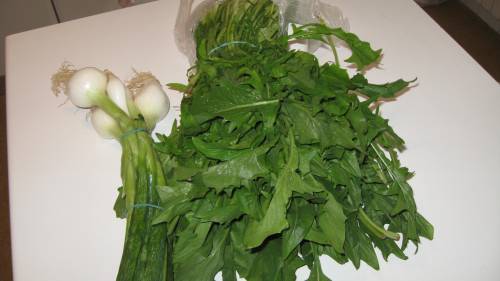Of activity, that is. (The real flurries are more like blizzards, falling on friends and relatives all up and down the east coast.)
But life here has been moving so fast, and what do I have to show for it? No photos of food, anyway. The food has disappeared before the camera reached it. Friday night they served latkes with dinner, and many of us ate three or more. They were just so good! Crispy crunchy on the outside, soft and hot on the inside, potato goodness throughout. Our Saturday lunch was another bonanza of flavors. The risotto, in particular, was impossibly delicious. Lemony, smooth, perfectly toothsome. That evening, yesterday, we hosted a pizza party. Twenty or so friends filled our living room, bringing beer, wine, chocolate, good stories and loud laughs, and I somehow managed to keep serving hot pizza in defiance of the size of our oven.
(I’ve actually done some roasting, baking, and pizza making in it. My grandma used just a toaster oven for years….)
The pizza came from our local favorite, Pizzeria da Simone. People are constantly coming in and out of this pizzeria on Via Carini, at all hours of the day. Pizza rossa for breakfast? No problem. We got a whole range of toppings last night: zucchini blossoms and anchovies, sausage with cheese, sausage with mushrooms, spicy sausage with tomato sauce, mushrooms with tomato sauce, prosciutto with cheese, mortadella with artichoke hearts. It was all devoured before I thought to take a picture. I love Roman style pizza. The crust is like what we’d call flatbread, but isn’t completely flat, and the toppings are combined in moderate twosomes or threesomes. None of this deep dish everything nonsense. (How will we ever reacclimate?)
This morning, Peter and I, along with Ramie, Rena, and Lisa, ran the 10K “Christmas Run” in Villa Pamphili. The scene was a fascinating cultural tableau. We were some of the only Americans in the crowd of 400. The race was set to begin at 9:30, but the organizers and pace-setters lingered in the cafe adjacent to the “Punto Jogging” for an extra 15 minutes of leisurely cappuccino sipping. Finally, after we had been jumping up and down in the 28-degree air (that’s Farhenheit!) waiting, the pace-setters, who wore color-coded balloons, took their places and the race got off to a silly, stumbling, good-hearted start. Some of the runners, being typical Italians, talked the whole while. Except on the uphills. The course, like the balloon-following, was whimsical, winding through forest on narrow, muddy trails, and up grassy hillsides sparkling with frost, past fountains and the chestnut-lined avenue on this awesome piece of land that until recently was a massive chunk of private property on one of the prettiest hills in Rome. I ended up running in a pack of middle-aged men, who were yelling and laughing to each other the whole time, (Ciao, bello! Buon Natale! Attenzione! along with much commentary on the mud puddles) and one other woman, who wore a set of red antlers. Some people were dressed up as Babbo Natale (that’s Santa to you) and many wore the elf hats they gave us at registration. It was a fun-run with decidedly Italian inflections of the good life: the cafe at the finish was mobbed with sweaty people sipping espresso, talking loudly, and gesticulating heartily. The men wore tights, and the women’s black eyeliner was unmussed.
Back home, Peter and I polished off the leftover pizza, and I cooked some pasta for these elves:

















